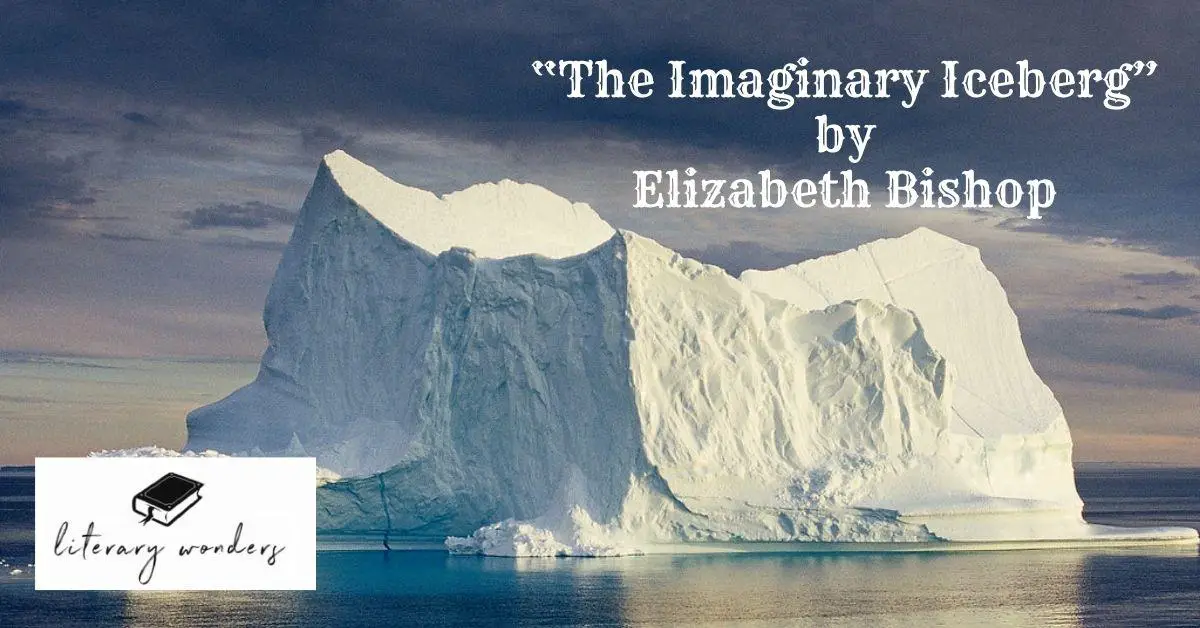“The Imaginary Iceberg”- Introduction
“The Imaginary Iceberg” is penned down by Elizabeth Bishop, a great American poet and writer. The descriptive poem speaks about the matchless and everlasting beauty of the natural world. The poem begins where the speaker prefers to have an iceberg than a ship. Despite knowing that the iceberg stands still, she desires to own this giant motionless ice rock. Although the boat takes us on distant travels, allowing us to discover the world’s hidden treasures, she likes to have an iceberg.
She believes that this eye-catching Snowy Mountain does respond to the sailors; it provides an exciting view to their eyes. Ironically, a ship passes by it and ignores it, but the glassy pinnacles artistically appear and disappear. Also, its most delicate top constantly gets redesigned by the shift of weather. The airy twist of snow acts as an artist as it brings noticeable changes to it. Despite facing various weather conditions, it stands firm and stares upon the surroundings. To her surprise, it cuts its edges cleverly by itself, providing us a chance to adore its fleshed, fair, and erected indivisible features.
Major Themes in “The Imaginary Iceberg”
Man and the natural world, mesmerizing natural beauty, and appearances versus reality are the poem’s central themes. Throughout the poem, the speaker contemplates her imagination; she allows the readers to step into her imaginary world and see how it casts a magic spell. Her imaginary iceberg seems perfect, unique, and unmatchable, but it exists only in her imagination. No one else can feel something special about this giant ice rock. The natural world is indeed captivating, alluring, and mesmerizing, yet no one puts a full stop on his life to enjoy these bounties till his last breath. We adore the wonders of nature and then catch the normal pace of our life. Similarly, no matter how much time we waste creating a useless imaginary world, we have to open our eyes and live the realities of life. Even the most captivating memories and fantasies disappear in the wink of an eye.
Analysis of Literary and Poetic Devices Used in “The Imaginary Iceberg”
Elizabeth Bishop has inserted various poetic elements in this poem to make her readers visualize the beauty of her imaginary iceberg. Some of the devices used in this poem are;
1. Epigraph
2. Personification
3. Imagery
4. Symbolism
5. Metaphor
This first device that seems evident at the start of the poem is epigraph. It is a significant device used at the beginning of the poem to exhibit the overall theme of the poem. The straightforward suggestion of the speaker in the opening line clearly hints the key idea of the poem such as; “We’d rather have the iceberg than the ship.” The second important device is the use of personification. By definition, it allows the writers to give humanistic qualities to inanimate objects. Elizabeth has personified her imaginary iceberg in the poem such as; “The iceberg cuts its facets from within.”
Offering an impressive depiction of specific ideas and emotions, she has used iceberg as an extended metaphor for human life that has undergoes various changes with time. Similarly, she has used visual imagery to make her readers visualize the tremendous appearance of the giant ice rock which usually remain unnoticed by the travelers. The use of symbolism has further escalated the soothing impact of the poem. Moreover, the division of the poem into three equal length stanza helps the reader understand the coherent approach of the writer.
In-depth Analysis of “The Imaginary Iceberg”by Elizabeth Bishop
Stanza #1
This stanza states the speaker’s opinions; she prefers the iceberg on the ship. Knowing that it makes the end of travel, while the boat takes its travelers to the places beyond imagination, she advocates having a breathless plain of snow. She accounts for the distinct character of the iceberg when she says that “the iceberg takes the response from you.” She believes that the seemingly giant rock of snow is actually still or breathless.
Stanza #2
In this stanza, the speaker further highlights the striking features of the iceberg and how nature contributes to its extraordinary existence. Undoubtedly, the sailors get amazed by the classy presence of the iceberg in the ocean. They praise it for a moment and then sail on, ignoring how natural elements play their unique role to create this artistic piece of giant snow. The sun, the wind, and even the clouds play a significant role in its appearance and disappearance.
Stanza#3
After analyzing the unique characteristics of the iceberg, the speaker seems to catch the actual ground in this stanza. The writer compares our fantasies to jewelry in a grave, implying that no one can see these fantasies. We are the only ones to know our imaginations that are forsaken in our minds. The significant end of the poem comment on the very nature of the mankind; we love to get lost in an imaginative world, ignoring the complex world around. But, unfortunately, life shakes us and brings us back to the place where we belong.
See Also:

